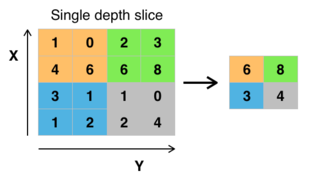减少75%的数据量 它的精确位置远不及它和其他特征的相对位置的关系重要

zh.wikipedia.org/wiki/卷积神经网络
池化(Pooling)是卷积神经网络中另一个重要的概念,它实际上一种形式的向下采样。有多种不同形式的非线性池化函数,而其中“最大池化(Max pooling)”是最为常见的。它是将输入的图像划分为若干个矩形区域,对每个子区域输出最大值。直觉上,这种机制能够有效地原因在于,在发现一个特征之后,它的精确位置远不及它和其他特征的相对位置的关系重要。池化层会不断地减小数据的空间大小,因此参数的数量和计算量也会下降,这在一定程度上也控制了过拟合。通常来说,CNN的卷积层之间都会周期性地插入池化层。
池化层通常会分别作用于每个输入的特征并减小其大小。目前最常用形式的池化层是每隔2个元素从图像划分出{\displaystyle 2\times 2}
除了最大池化之外,池化层也可以使用其他池化函数,例如“平均池化”甚至“L2-范数池化”等。过去,平均池化的使用曾经较为广泛,但是最近由于最大池化在实践中的表现更好,平均池化已经不太常用。
由于池化层过快地减少了数据的大小,目前文献中的趋势是使用较小的池化滤镜,[4]甚至不再使用池化层。[5]
【部分表示整体,受益与仿生学】
https://en.wikipedia.org/wiki/Convolutional_neural_network
Work by Hubel and Wiesel in the 1950s and 1960s showed that cat and monkey visual cortexes contain neurons that individually respond to small regions of the visual field. Provided the eyes are not moving, the region of visual space within which visual stimuli affect the firing of a single neuron is known as its receptive field. Neighboring cells have similar and overlapping receptive fields. Receptive field size and location varies systematically across the cortex to form a complete map of visual space. The cortex in each hemisphere represents the contralateral visual field.
Their 1968 paper[13] identified two basic visual cell types in the brain:
- simple cells, whose output is maximized by straight edges having particular orientations within their receptive field
- complex cells, which have larger receptive fields, whose output is insensitive to the exact position of the edges in the field.



